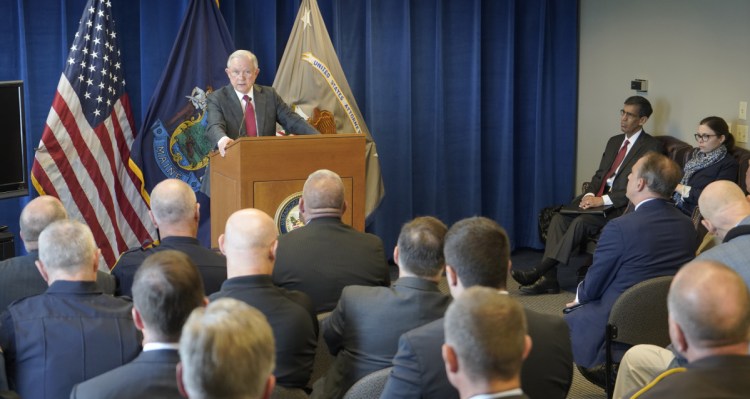U.S. Attorney General Jeff Sessions was in Portland last week to unveil a new crackdown on drug traffickers. But it might as well have been 1992.
The Justice Department, Sessions announced, is launching an “enforcement surge” in areas that have experienced high rates of opioid overdoses. In this effort, the department says, no case is too small for prosecutors – put enough people behind bars, and the epidemic will trail off.
“This new strategy – and the new prosecutors who will help carry it out – will help us put more traffickers behind bars and keep the American people safe from the threat of these deadly drugs,” Sessions said in a statement issued before the event.
But this strategy is nothing new. In fact, it’s the same strategy that has failed before. The date may change, but one thing does not: While we never have enough money for the treatment that helps people with addiction recover, we always have plenty to put them behind bars, despite all the evidence that it does little for public health – or public safety.
Sessions says the effort will target large traffickers of fentanyl and other synthetic opioids, highly fatal drugs that are driving the overdose rate. More likely, it will fill jails and prisons with users and low-level dealers, driving up costs while doing little to stop the supply of the deadly drugs, and nothing to quell the demand.
The crackdown, dubbed Operation Synthetic Opioid Surge, or S.O.S., will take place in northern and southern Ohio, eastern Tennessee, eastern Kentucky, northern and southern West Virginia, eastern California, western Pennsylvania and New Hampshire, as well as Cumberland County.
Federal prosecutors in those areas won’t find the large-scale traffickers that smuggle fentanyl and its analogues into the country from China and Mexico.
But they will find people struggling with all the complex issues that surround addiction.
Along with those who are just not ready to be helped, they’ll find people who want treatment but can’t access it, either for lack of availability or lack of money. They’ll find people who are on and off the wagon, or who use just enough to get through the day, unsure of the next step. They’ll find people who sell drugs to fund their own addiction. They’ll find low-level dealers who will be replaced as soon as they’re taken off the street.
Some of those people deserve jail; others don’t. Some would benefit from incarceration; others wouldn’t. But those subtleties are never considered when it comes to enforcement – prosecutors and police are just handed money and resources with little question.
Contrast that with the treatment side, which is always asking for more but never given enough.
President Trump’s commission on the opioid epidemic stressed that it should be treated from a public health perspective, with a focus on treatment, harm reduction and prevention. That’s the same conclusion reached by almost every task force on the subject, including two in Maine. And in just about every case, they’ve been ignored while policymakers ask for more arrests.
The Legislature only recently approved a modest treatment spending proposal over the objections of Gov. LePage, who has vetoed other treatment funding in the past while also fighting the use of the overdose-reversing drug naloxone and Medicaid expansion, which would help cover treatment for a lot of Mainers.
In fact, the same day Sessions came to Portland to announce $6 billion in funding for drug enforcement, one of the city’s longest-running treatment programs announced it was closing. The reason? A lack of funding from the federal government, and indifference from the LePage administration.
Send questions/comments to the editors.


